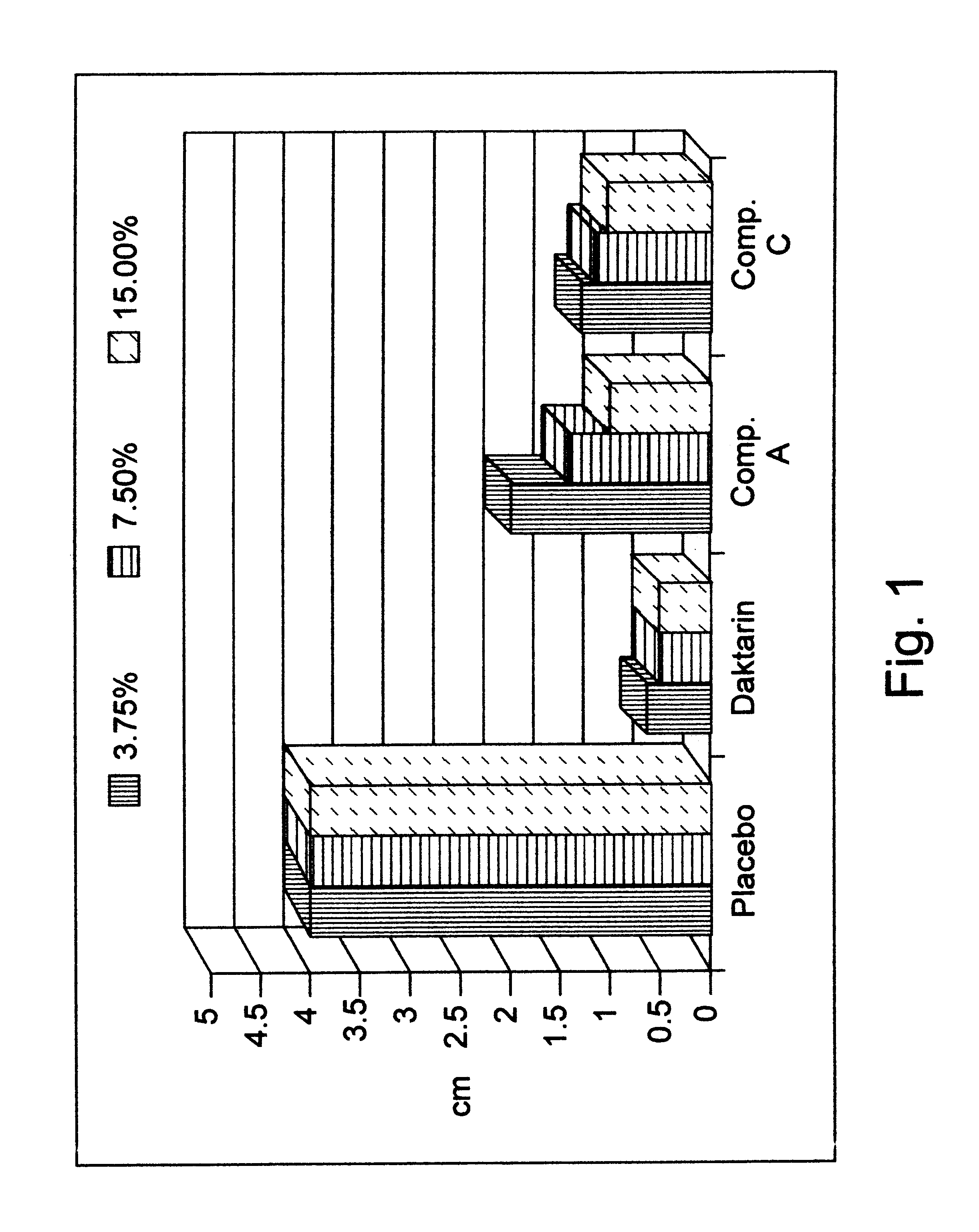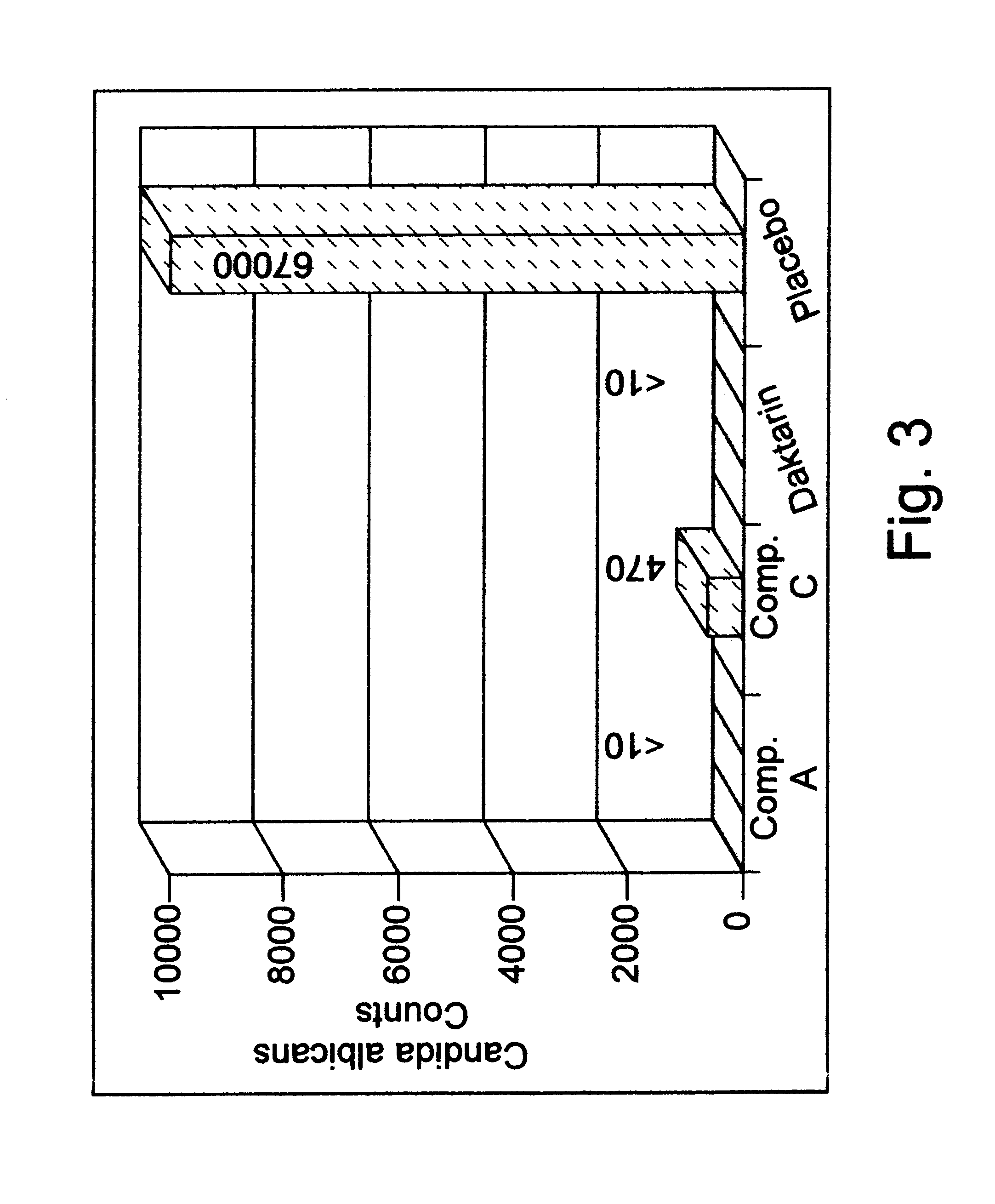Anti-fungal compositions with prolonged activity
a composition and antifungal technology, applied in the field of antifungal compositions with prolonged activity, can solve the problems of lack of significant anti-inflammatory activity of herbal preparations, combination that has demonstrated antifungal activity, and lack of prolonged antifungal and antibacterial activity, etc., to inhibit the growth of aspergillus niger, clear antifungal properties, and inhibit the effect of growth
- Summary
- Abstract
- Description
- Claims
- Application Information
AI Technical Summary
Benefits of technology
Problems solved by technology
Method used
Image
Examples
example 1
Anti-Fungal Effects of Compositions of the Present Invention
A composition of the present invention was tested for its effect against fungal activity. The composition included 4.6% Phytolacca extract, 4.6% Coneflower extract, 3.1% Symphytum extract, 3.1% Calendula extract, 3.1% Hamamelis extract, 1.5% Propolis extract, 0.5% Thyme oil and 0.5% Lavender oil, as the active ingredients. Two different fungal species were tested, Candida albicans and Aspergillus niger. These fungi were grown in a suitable solid growth medium, TSA (Difco, Detroit, Mich., USA) to which 10%, 5%, 2.5%, 1.25% of either the composition or alcohol (as a control) was added. As a further control, fungi were also grown without the addition of either the alcohol alone or the composition. Results are shown in Table 1 below.
As shown in Table 1, alcohol alone did slightly inhibit the growth of Candida albicans, with a MIC of 10%. As noted above, MIC is the minimal inhibitory concentration, which is the lowest concentrat...
example 2
Anti-Fungal Effects of Separated Components of Compositions of the Present Invention
A composition of the present invention, either complete or with one component removed, was tested for the effect against fungal activity. As for Example 1, the composition included 4.6% Phytolacca extract, 4.6% Coneflower extract, 3.1% Symphytum extract, 3.1% Calendula extract, 3.1% Hamamelis extract, 1.5% Propolis extract, 0.5% Thyme oil and 0.5% Lavander oil as the active ingredients. One fungal species was tested, Aspergillus niger. The fungi were grown in a suitable solid growth medium, TSA (Difco, Detroit, Mich., USA) to which 15%, 7.5% or 3.75% of the composition, the composition with one component removed, the commercially available anti-fungal agent Daktarin or alcohol (as a control) was added. Both colony diameter was measured, in centimeters (cm), and the presence or absence of sporulation five days after the addition of the test substance. Results are shown in Table 2 below.
As shown in Tab...
example 3
Anti-fungal Preparations and Methods of Administration
As noted above, combinations of a tincture and an essential oil show strong, prolonged anti-fungal activity. These combinations can be used in a number of formulations. Furthermore, these formulations can be administered to a subject in a number of ways, which are well known in the art. For example, administration may be done topically (including ophtalmically, vaginally, rectally, intranasally), locally in the oral cavity or by inhalation.
Formulations for topical administration may include but are not limited to lotions, ointments, gels, creams, suppositories, drops, liquids, sprays and powders. Conventional pharmaceutical carriers, aqueous, powder or oily bases, thickeners and the like may be necessary or desirable. The suppository can also take the form of a soap or ovules.
Compositions for local oral administration may be prepared in a similar fashion, in the form of toothpastes, creams, ointments, gels, aqueous solution, othe...
PUM
 Login to View More
Login to View More Abstract
Description
Claims
Application Information
 Login to View More
Login to View More - R&D
- Intellectual Property
- Life Sciences
- Materials
- Tech Scout
- Unparalleled Data Quality
- Higher Quality Content
- 60% Fewer Hallucinations
Browse by: Latest US Patents, China's latest patents, Technical Efficacy Thesaurus, Application Domain, Technology Topic, Popular Technical Reports.
© 2025 PatSnap. All rights reserved.Legal|Privacy policy|Modern Slavery Act Transparency Statement|Sitemap|About US| Contact US: help@patsnap.com



